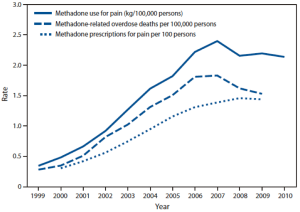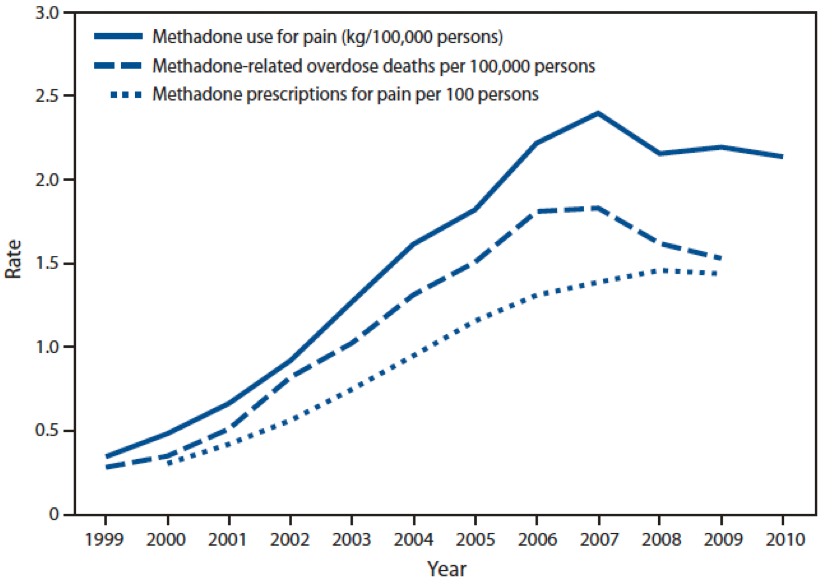
In 1964, Drs. Marie Nyswander and Vincent Dole read about methadone in the drug literature, thought it could be useful in treating heroin addicts, and methadone maintenance treatment was born. For the next three decades, methadone was primarily used in opioid maintenance treatment. Then in the mid-1990s methadone began to be used as an alternative medication for chronic pain. But there were problems when methadone was used for pain relief—people began dying from accidental overdoses.
Methadone has some advantages as a pain reliever. Its longer duration of action meant it could be taken only 2 or 3 times a day rather than 4 to 6 times a day. It is also lower in cost than other prescription painkillers. Insurance plans see methadone as a cheaper, generic alternative to other long-lasting painkillers like OxyContin. A Consumer Reports comparison of the estimated costs for long-acting opioids indicated that the average monthly cost for 5 mg methadone pills was about $17. The monthly cost for 10 mg sustained-release OxyContin was $164. Fentanyl extended-release 25 mg was $303.
By 2009, methadone accounted for almost 1 in 3 prescription painkiller deaths. More people overdosed on methadone than heroin. SIX TIMES as many people died from methadone overdoses in 2009 than in 1999. See the following chart taken from the CDC “Morbidity and Mortality Weekly Report” for July 6, 2012.
 One of the issues was that the FDA-approved package insert for methadone recommended high initial doses of up to 80 mg per day. As reported in the NYT article, “Methadone Rises as a Painkiller With Big Risks,” Dr. Robert Newman, an expert on addiction said: “This could unequivocally cause death in patients who have not recently been using narcotics.” In November of 2006, after overdose deaths from methadone became more widely known, the FDA decreased the recommended starting limit to no more than 30 mg per day.
One of the issues was that the FDA-approved package insert for methadone recommended high initial doses of up to 80 mg per day. As reported in the NYT article, “Methadone Rises as a Painkiller With Big Risks,” Dr. Robert Newman, an expert on addiction said: “This could unequivocally cause death in patients who have not recently been using narcotics.” In November of 2006, after overdose deaths from methadone became more widely known, the FDA decreased the recommended starting limit to no more than 30 mg per day.
However, it has been reported that lethal respiratory problems can still occur with doses as low as 30 mg daily with some individuals. The problem is that methadone can take as long as two weeks to be converted into inactive metabolites with methadone-naïve patients. So the accumulation of methadone, especially with methadone-naïve individuals, can lead to “sedation, respiratory depression respiratory arrest and even death.” These same effects can occur with someone who is tolerant of opioids, but generally takes higher doses.
The respiratory depressant effect from methadone typically peaks later and lasts longer than its analgesic effect. In other words, someone taking methadone for pain will have relief for about 4 to 8 hours. But the methadone is still pharmacologically active. Taking more methadone for pain relief could mean greater toxicity and the danger of respiratory problems, since the recent dose for pain relief combines with the still-not-fully metabolized methadone of the first dose.
Sadly, if the history of methadone had been taken to heart, perhaps some of these problems could have been avoided. Maybe some of the accidental overdoses could have been prevented.
Methadone was first synthesized in the mid-1930s as an alternative painkiller to morphine, which the Germans anticipated the Allies would not be willing to share with them once war was declared. Known at the time as polamidon, it was never brought into commercial use. An American doctor, who did a good bit of the early clinical research with it after the war, said a former employee of the German company that invented polamidon (methadone) told him they had discounted its usefulness because of the side effects.
The factory where polamidon was invented came under the control of the Americans after the war. All German patents, including those for polamidon, were requisitioned as spoils of war. Eli-Lilly and other pharmaceutical companies began clinical trials on what was thought to be a revolutionary new painkiller, now with the name of dolophine—combining the Latin word dolor (pain) and the French word fin (end).
A 1947 study by Isbell et al. noted that volunteer subjects had problems with rapidly developing tolerance and euphoria. There were also signs of toxicity, inflammation of the skin, deep narcosis (unconsciousness) and a general appearance of illness with high doses. They also observed that: “morphine addicts responded very positively” to dolophine. They concluded that dolophine could be highly addictive: “We believe that unless the manufacture and use of methadon [methadone] are controlled addiction to it will become a serious health problem.”
The philosopher George Santayna said: “Those who cannot remember the past are condemned to repeat it.” In the case of methadone, it seems that those who don’t remember the past are condemned to suffer the consequences.
Also read, “Chained to a Dragon.”





